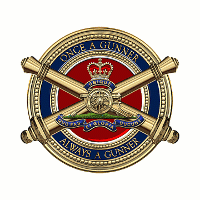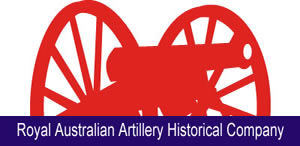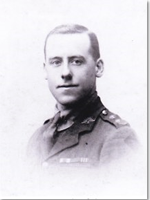During this action he mended and kept lines of communication going although constantly under enemy fire. Promotion to Bombardier on 23 August 1916 went with the award of the MM and this modest hero in a letter home enclosed a photo wearing his new stripes and a piece of ribbon, but did not mention his award.
Promoted to Sergeant on 17 March 1917, Ewen was again in the heaviest of the fighting and was awarded the Distinguished Conduct Medal ’for conspicuous gallantry and devotion to duty. After all the (105th Howitzer) battery officers had been wounded, and many casualties sustained by heavy shell fire, he took command, and by his splendid example under very trying circumstances, was able to complete the task of bringing the guns into position’. (London Gazette’ 17 July 1917). Bombardier Church who witnessed the action said Sergeant Ewen’s coolness and bravery under fire were perfectly marvellous. As a result of this action and outstanding leadership for the period of his service, Sergeant Ewen was sent to England where he underwent a promotion course to gain commissioned rank.
Lieutenant J.C. Ewen DCM was in charge of the 4th Australian Field Artillery Brigade’s communication and forward observation party at Herleville on 23 August 1918. The forward observing officer was killed and Ewen at once took his place. Throughout the day, under very heavy hostile fire, he moved about the newly captured positions, sending back important information to allied positions and bearings to hostile batteries which were shelling his unit’s new positions, and which were at once engaged. Ewen displayed an utter disregard for personal safety and much information of tactical importance was received from him. This action resulted in his being awarded the Military Cross (‘London Gazette’ 1 February 1919) and General Birdwood in a letter to Ewen made the following statement: ‘I should also like to congratulate you on your splendid record in having gained the MC, DCM, MM. It is indeed one of which you may be proud’.
Lieutenant Ewen was wounded in this action and did not return to duty until 31 March 1919.
Whilst serving in France, Lieutenant Ewen rescued a little dog which became the unit mascot and when his master went forward into hostile shelling areas, he would be told to stay, and stay he would until his master returned and picked him up. The dog was eventually smuggled inside Ewen’s overcoat to England where his mother and sister looked after him. Lieutenant Ewen was presented with his three decorations at Buckingham Palace.
On his return to Australian his AIF appointment was terminated on 24 July 1919 and he was placed on the Reserve of Officers, 2nd Military District. Jack Ewen started a pest control business about 1925 which was very successful. The business was extended to include building renovations and later to building contracting. In 1946 the business was taken over by his two sons, both chartered builders. J C Ewen and Co is today a well established firm in Chatswood, Sydney
Although placed on the Retired List on 1 September 1926, Lieutenant Ewen volunteered for service in the Second World War and on 1 April 1940 was appointed to the Regimental Reserve List RAA (Militia), 2MD and promoted to Captain on 1 September 1942. After many attempts and great insistent, Captain Ewen was sent to New Guinea and promoted to Major on 12 January 1943. In this rank he commanded 53rd Battery, 14th Field Regiment. (Ed’s note: This is now the support battery to the School of Artillery in Puckapunyal).
After returning to Australia, Major Ewen served in training appointment in Queensland till 13 March 1944 due to his age (52) and the availability of younger officers, his military service ended.
Jack Ewen died on 20 November 1951 and was cremated at the Northern Suburbs Crematorium, Sydney.
Post Script
An Australian flag, presented to Ewen by the residents of Bellingen, when he enlisted in the First World War and he carried it as a reminder of Australia throughout the war. As Australian flags were not issued to units serving overseas, Ewen’s flag was often called into service for various ceremonies in France. His mother subsequently embroidered the names and dates on the flag which is now held at the Australian War Memorial. |







